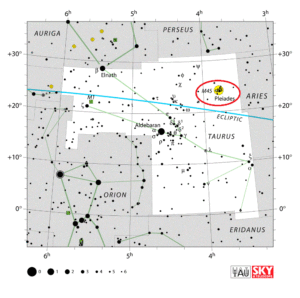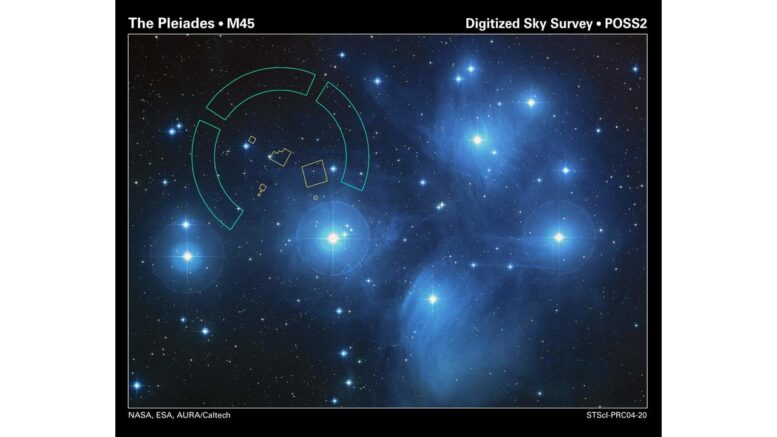Commonly called the Pleiades or Seven Sisters, M45 is known as an open star cluster that contains over a thousand stars that are loosely bound by gravity, but it is visually dominated by a handful of its brightest members. The Pleiades cluster has been observed since ancient times, so it has no known discoverer.
| Description | |
| Visible From Pacific Northwest | September to February |
| Best Time To Observe | December and January |
| Minimum Size Of Viewing Device | Binoculars |
| Object Type | Open Cluster |
| Designations | Messier 45, M45, Pleiades, Seven Sisters, Subaru, Collinder 42, Melotte 22, C 0344+239, OCl 421.0, H 0346+24, MWSC 0305 |
| Right Ascension | 03h 47m 24s |
| Declination | +24°07′ |
| Constellation | Taurus |
| Number Of Stars | More Than 1,000 |
| Apparent magnitude | +1.6 |
| Apparent dimensions | 110′ |
| Object Radius | 8 light years |
| Distance From Earth | 444 light years |
History
Charles Messier catalogued the Pleiades as Messier 45 on March 4, 1769, describing the object simply as a “cluster of stars, known by the name of the Pleiades. The position reported is that of the star Alcyone.”
In 1767, John Michell, English clergyman and philosopher, proposed that the stars in the cluster had to be physically related because the likelihood of a chance alignment of so many bright stars was 1 in 500,000. His theory was confirmed later, when scientists began to study the stars’ proper motions and discovered that they were all travelling in the same direction and at the same rate. Michell is also known for being the first person to propose the existence of objects whose gravitational fields are too strong for light to escape, also known as black holes.
In 1782, French astronomer Edme-Sébastien Jeaurat drew a map of 64 stars of M45 based on his observations of the cluster. The map was published in 1786.
Locating M45 In The Sky
Finding M45 is easy. The cluster is positioned about 14 degrees northwest of orange giant star Aldebaran (mag. +0.9), the brightest star in Taurus. At first glance with the naked eye, it’s obvious that something is special about this small section of sky.

Viewing M45
The cluster is home to more than 1,000 confirmed members, but only a handful of these stars are visible to the naked eye.
The Pleiades cluster occupies an area of 110 arc minutes, about four times the apparent diameter of the full Moon. Up to 14 stars are visible without binoculars in good conditions, with clear skies and no light pollution. The best time of year to observe M45 from northern latitudes is during the winter months, when Taurus constellation rises high in the sky. Because of the cluster’s apparent size, the best way to see it is through binoculars and small or wide field telescopes. Higher magnification is only recommended for studying individual stars.
Photographing M45
Of all of the star clusters in the sky, the Pleiades, is the easiest star cluster to photograph! M45 is huge, extremely bright, and looks amazing in both close up shots using a telescope, or through wide field astrophotography.
Messier 45 can be imaged in a plethora of ways including a DSLR and telescope, DSLR and a wide lens, and then also a CMOS camera with a telescope. All of these methods will have different ways to obtain the images, that vary from 1 hour of total exposure to 3 hours of total exposure. It will vary depending on the gear one uses, but this is an amazing opportunity to gain images of a wonderful open cluster. 3 to 5 minutes of exposure per photo can be enough to gather enough data per shot.
https://www.astropix.com/html/deepsky/m45_the_pleiades.html
https://www.galactic-hunter.com/post/m45-the-pleiades-star-cluster
Sources And Further Reading
Descriptions of all of Messier Objects can be found here.
https://www.nasa.gov/feature/goddard/2017/messier-45-the-pleiades
https://freestarcharts.com/messier-45
https://www.messier.seds.org/m/m045.html

Leave a comment